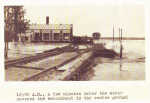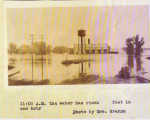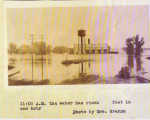Power plant worker recounts 1935 flood

EDITOR'S NOTE: Louis B. Wolf worked at the McCook Power Plant and remembers the Republican River floods of the summer of 1935 -- On May 28, May 31, June 13 and June 16/17. In a story that he wrote, Wolf calls the May 31 flood "The Big Flood."
These are his memories, a copy of them provided by his daughter, Carol Wolf Britton:
IN THE SPRING OF 1935, the fertile valley of the Republican River and its tributaries had overflowed several times, and we can now think of the floods of 1935 by numbers. At McCook, the river was at flood stage four times in 20 days. The first flood, May 28, 1935, the second or really "Big Flood" occurred on May 31, 1935, the third on June 13, 1935, and the fourth on June 16 and 17, 1935.

The second was the Big Flood -- as it will be designated in this narrative -- is the worst known in this valley to any one living, as far as can be learned. Score of lives were lost, dozens of homes washed away and ift destroyed thousands of acres of land rendered worthless for several years, and some forever, and caused millions of dollars of other damage on the 250-mile front of the river in Nebraska alone. In the McCook area, there were six homes completely destroyed and several moved from their foundations. This story will be limited to the flood and the (McCook) power plant.
The Big Flood started early in the morning of May 31, and at McCook, reached its peak in the afternoon, but water continued to run in the usually dry ditch near the power plant almost continuously until the latter part of June. From newspaper reports, we gather that damaging rains fell around Denver, Colorado, in the Republican watershed on May 30, and that the peak of the flood entered Kansas near Superior on June 1, 1935.
At about 4:a.m., the operator on duty at the power plant sent out the warning that water was running in the ditch north of the plant. Employees were called and requested to secure other men and report to the plant as soon as possible. By 5 a.m., some 12 men had reported for duty and were filling sacks with sand and cinders. A wall of bags was built around the doors to keep out the water as had been done on the 28th.

As the water continued to rise, more bags were secured and more shovels purchased until there were enough for all men. In a short time, the land outside of the wall of bags was entirely under water and it was necessary to fill the bags with cinders only. One cinder car had been sent to us two days before and that morning, two more were switched down near the power plant, by the CB&Q Railroad.
The water soon reached the level of the previous high water, but we felt safe, for the new dam was wider and built better than the one that had been torn down the day before.
In the meantime, men inside the plant were also busy. Preparations were being made to cope with the water if some of it seeped through the wall and reacher the power plant doors. All the doors except two were closed and sand bags placed against them to keep out the seepage. The sand bag walls were not very long, and soon the 30 or more men working on them could not keep ahead of the water.
There was a cry from someone that the water was washing out our sand bags at the front wall and all the men around there rushed into the plant. In a few seconds, the terrific force of the water obliterated all signs of the four-foot rampart we had built. It was not long until the walls at the rear of the plant also gave way, and the men who were not on the train cars were all inside the power plant. The water was now against the doors and the seepage was becoming a serious problem. It was about this time that we realized that the embankment on which we could have returned to land was washed out and that we were marooned, for the time being at least.
It did not worry us, for the water was almost as high a few days before and we thought it would soon begin to go down.
THE WATER CONTINUED TO RISE
Word was received from the chief dispatcher's office that the water had risen at the rate of two feet in 10 minutes in Culbertson. The plea came from the business men, "not to let the plant go down regardless of what happens," made us double our efforts to not be whipped by the flood. Even the discouraging news of rapidly-rising water was not enough to make us cease our efforts to keep up the service.
THE PLANT SHUT DOWN
It soon became too much, and we were forced to shut down the large engines and cut off the current to the city at 10:50 a.m. We continued to operate one of the small engines until 11:20 a.m., when water on the floor made the operation of these engines unsafe.
Although the plant was shut down, the work seemed hopeless. We kept ourselves busy. The seepage through the cracks around the doors was increasing and the well house pit was filling up fast. Several motors in this room were loosened from their foundations (by the men) and were carried to a safe place where they would not get wet, so we thought, and water was also running in the oil pump pits. Efforts made to remove the motors from these were unsuccessful for the water was filling these pits very fast.
The motor generator set was dismantled and put on the large engines. Some of the men started bailing out water and were hoping to get rid of the seepage as fast as it came in, when suddenly we heard a crash, and a cry came from the men on the old section of the plant. One of the doors in the rear had broken down, permitting the flood to enter the plant.
This drove us all onto the switchboard and on the top of engines. When the rush of water entered the plant, one of the men, instead of seeking safety on a large engine, climbed onto one of the smaller engines, taking with him a piece of garden hose. From there he reached the roof through the penthouse over the engine. Those of us perched on the top of the large engines could see the flood outside only through some of the small windows. We felt the men on the cinder cars outside were safe and comfortable, until we realized the water was so high the cars were beginning to float away. There was a mad scramble to the west wall by some of the men inside who could swim.
The water was about five feet deep inside the plant now. The larger part of the men inside in two of the cars succeeded in entering the plant through the windows. Two of the men on the car near the oil unloading station were thrown into the water and saved themselves by climbing onto the roof of the old portion of the power plant. The first employee on the roof, by using the rubber hose as a rope, assisted the two of the men onto the roof. Thus all employees were saved by coming into the plant or climbing onto the roof.
The water continued to rise until it appeared that we, standing on top of the large engine, would soon be standing in the water. Some of the men tried to make a hole in the corrugated asbestos roof but we had only a short piece of board and this was not large enough to pound a hole through the thick roofing. The men on top must have heard us, for in a short time we heard a crash and a board came through the roof from above, striking one of the men on the forehead. After the hole was enlarged, we all went through onto the roof, where we spent the next 24 hours.
From the roof, we saw a crowd of people on the banks some 400 feet away, our wives, mothers, fathers and friends. Under normal conditions, we could have conversed, but the loud roar of the water made it impossible. One or two suggested trying to swim to shore but this idea was quickly put out of their minds as we did not believe that anyone could get across the water to land. We were helpless until the water subsided, and realized all we could do was to remain where we were.
On the shore there was a great deal of confusion. Hundreds of people flocked to the water's edge. Finally a plan to send a rope across the plant was carried out. The insulators were shot off one of the wires from the land to plant with high-powered rifles. To this, a large rope was attached and we on the roof pulled it to the power plant. A telephone cable car and land-line were brought over on the rope so that we could pull the cart to and from the land. The two H frames, to which the wire had been fastened and which now held the rope, had to be crossed and one man was stationed at each frame to assist the rescued men in changing the car from one side of the pole to the other. Two men were thus transfered from the roof to the land. As we were about to start the third man, the water washed out the poles and the employee on the H frame near the plant dived into the flood. By his skillful swimming, he succeeded in reaching a point near land about one-fourth of a mile below, where he was thrown a rope and rescued.
The washing out of the poles and breaking of the rope ended the attempt to rescue us in this manner. Towards dusk, we saw the launching of a large pontoon and were not surprised to see the current carry it back to land. It is well that no further attempts were made to rescue us that night.
Finally, darkness came and with it, a certain feeling of despair at the thought of the long hours before us with the roar of the flood and the lapping of the waves against the walls. We did not know how long the walls of the portion of the plant on which we were then staying would stand the force of the water. The north or front of the plant, which we always considered as being unusually strong, had been undermined already.
Possibly the greatest relief we had during the night was the light shining on the plant from the engines on the oil spur, and the fire truck and other cars to the east. No one except we who spent the night on the roof know the cheer we received from those lights.
The afternoons showers and the cold wind did not add to the pleasure of our enforced stay in the open. There was some physical comfort by lying together on the roof where we could get a little bit of protection from the wind. Of course, the men on the outside were cold and were forced to change place with the men on the inside from time-to-time. Some of us slept several hours that night while others walked around most of the time.
At last, dawn came and with it, sunshine and hope that the water would recede sufficiently to permit us to return to land. Several attempts were made to have small boats come to the plant. Finally, two men succeeded in rowing to us with sandwiches, coffee and water, the first food we had for more than 24 hours. Later, two others rowed out and took back three of our roof dwellers. One of them had injured his hand the day before and we wished to get him home where he could consult a doctors as soon as possible.
Later, when the water had gone down sufficiently, we waded out to a sandbar near the cooling tower, a large boat was brought to us and from then on, trips were made taking seven or eight men each time until we were all landed safely on land.
The last boat reached land at about 2:30 p.m.
Forty of us had been marooned by the worst flood in the history of the valley with nothing but a few cigarettes to satisfy hunger and thirst.
Not one of us was seriously injured or suffered very much from the experience.
During the period of our isolation in and on the power plant, there was very little general conversation. The men were not panicky and at no time was there a rush to be first when an opportunity presented itself for rescue. In fact, it was necessary for the manager, who was with the marooned group, to call out the men who were to be rescued. This was done without favor, as nearly all the workers were strangers to him
THE ROOF MEN
The following men were trapped in the power plant, except Paul Wilson, who brought the telephone cable from land:
Jake Amen, W.R. Evans, Hugh Meyers, Floyd Albright, R.H. French, E.J. Nelson.
F.W. Anthony, Frank Gillen, W. Rishel, W. Baker, John Herbst, C.C. Parker, John Baker, John Herman, George Schlseman (Schleeman).
Cloyd Bell, Merl Huet, George Simmons, T.C. Bergin, A.S. Hockman, J.L. Snyder, Floyd Bower, J. R. Jaquet, Ed Sterr, Charles Clark, Harry Jenson, Gunner Swanson.
Oscar Clark, Ray Lytle, Stewart Walker, Carl Cottingham, V. Lytle, Paul Wilson, Lou Dulaney, Elmer Mapes.
Louis Wolf, Ralph Elwood, Mike Worski, Joe Ward and C.H. England.
Carol Wolf Britton wrote: When I was a kid, I used to walk down Ravenswood Road and it came to an abrupt end at the river. It was always a place that was a little eerie to me as that is where the homes had been that were washed away.
It always seemed odd to me that the road jus stopped like it did. I am sure it has changed a great deal over the years, and maybe one day I will get to walk down there again and see if I feel the same way about the area.
I think the work that was done that day was remarkable considering the pictures I have seen of the aftermath of the flood and the damage to the power plant. I am amazed that the building survived the strong flood waters.
This was a very proud moment for my father and he told the stories many times to us kids, and even my mother told us how worried she was, as she and my father were engaged at the time.
This article is dedicated to the memory of all those brave and hard-working souls that survived during this traumatic time.
